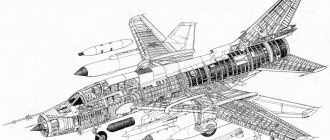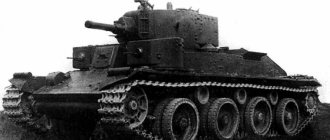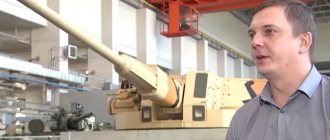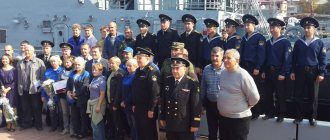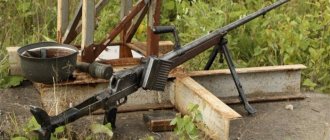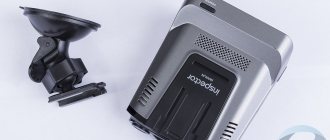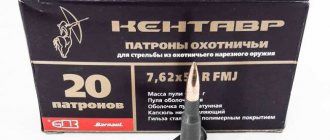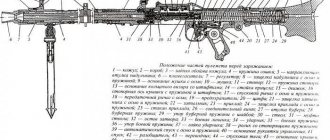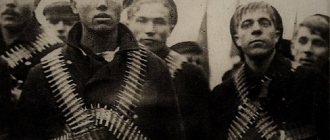| MiG-15bis | |
| Type: | Fighter |
| Developer: | OKB 155 |
| Manufacturer: | Aircraft plants No. 1 (Kuibyshev), No. 21 (Gorky), No. 31 (Tbilisi), No. 126 (Komsomolsk-on-Amur), No. 153 (Novosibirsk), No. 292 (Saratov), Aero Vodochody (Czechoslovakia), PZL (Poland ) |
| First flight: | July 22, 1949 |
| Start of operation: | 1945 |
| Status: | Withdrawn from service |
| Main operators: | USSR Air Force, North Korean Air Force, Chinese Air Force |
| Years of production: | 1950 — 1952 |
| Units produced: | 8354 |
| Base model: | MiG-15 |
MiG-15bis (according to NATO codification: Fagot , Faget - English Vyazanka) is a Soviet fighter developed by the Mikoyan and Gurevich Design Bureau, a development of the MiG-15.
Content
- 1 History of the creation of the MiG-15bis 1.1 MiG-15 “SL” and the VK-1 engine
- 1.2 MiG-15bis "SD"
- 1.3 Escort fighter MiG-15Sbis “SD-UPB”
- 1.4 MiG-15Rbis "SR-1" reconnaissance aircraft
- 2.1 MiG-15bis "SYA" with a wing of increased rigidity
Links
Drums MiG-23 • MiG-27 Intelligence MiG-15Rbis • MiG-21R • MiG-25R Educational and training MiG-9UTI • MiG-15UTI • MiG-21U, US, UM • MiG-23UB • MiG-25PU, RU • MiG-29UB • MiG-AT Experimental E-150 • E-152 • E-8 • I-75 • I-270 • I-320 • I-350 • MiG-8 “Duck” • MiG-105 • T-101 “Rook” Projects MiG 1.44 MFI • MiG-110 • MiG-125 • Skat UAV • PAK DP (MiG-41) • R-500
History of the creation of the MiG-15bis[ | ]
MiG-15bis in the American museum. The plane has North Korean Air Force markings.
MiG-15 "SL" and VK-1 engine[ | ]
In 1946, the V. Ya. Klimov Engine Design Bureau began developing an improved version of the RD-45F engine, which was a copy of the British Nin II. The VK-1 turbojet engine developed by Klimov had almost the same dimensions and weight as the RD-45F, and had 20% more thrust. Factory and state tests of the engine were carried out on four production MiG-15s, which received . At the beginning of 1949, state tests of the engine were completed, and on May 14, by decree of the Council of Ministers of the USSR No. 1887-697, the VK-1 engine with a 100-hour resource was put into mass production.
MiG-15bis "SD"[ | ]
In accordance with MAP order No. 386 of May 20, 1949, OKB-155 was instructed to modify the MiG-15 for the VK-1 engine. The aircraft was supposed to be presented for state tests in the summer of 1949, however, due to the delay in receiving the production MiG-15 for modification, the aircraft was presented for state tests only in early autumn.
MiG-15 No. 105015 equipped with the VK-1 turbojet engine received. Although the dimensions of the RD-45F were similar, due to the larger diameter of the extension pipe, it was necessary to slightly change the design of the tail section. The wing structure was also strengthened, and a 40 mm wide “knife” strip (from “fallen wood”) was riveted along the trailing edge of the wing; on the right aileron there was the same “knife” 30 mm wide. On the SD aircraft, a BU-1 hydraulic booster was installed in the aileron control, in the toe of the left wing console. Elevator compensation was increased by 22%, and the noses of the elevators and yaws were thicker.
Another major change was the new weapons; the NS-23KM guns were replaced by the NR-23, which had a higher rate of fire. The installation of these guns was tested on the MiG-15 SV. As on the later series of the MiG-15, the SD fighter had an ASP-3N sight. The plane could carry two 50 or 100 kilogram bombs or two 250 liter PTBs.
Factory tests of the SD fighter took place from July 22 to September 9, 1949. After their completion, the aircraft was sent to the Air Force Research Institute. State tests began on September 14, but soon after the start of the tests, the engine’s tendency to surge and “itching”—high-frequency shaking that occurred in combat modes, at an altitude of more than 8,000 meters—was revealed. The tests were interrupted three times to install a new engine, and state tests were successfully completed only with the fourth VK-1, although the identified problem was never completely resolved.
The Decree of the Council of Ministers of the USSR dated June 10, 1950 approved the Act based on the results of state tests and the launch of the fighter into series under the designation MiG-15bis.
Escort fighter MiG-15Sbis "SD-UPB"[ | ]
The USSR Air Force required an escort fighter for bombers, and therefore, OKB-155 was tasked with creating a variant of the MiG-15bis with a flight range of at least 2,200 kilometers.
To solve this problem, the Mikoyan Design Bureau modified the serial MiG-15bis No. 53210114, strengthening the wing and installing more powerful holders, thanks to which the fighter could carry two outboard tanks of increased capacity, 600 liters each. The modified aircraft was designated "SD-UPB". Due to the significantly increased take-off weight, the pressure in the tires was increased, and due to the increased flight time, an additional two-liter oxygen tank was added.
On September 14, 1950, state tests of the SD-UPB began. On the one hand, the designers achieved the required range for the fighter, on the other hand, when flying with external tanks, there were a number of restrictions for the fighter, and most importantly, the maximum permissible speed with the PTB was limited to 650 km/h. This did not allow escorting Il-28 and Tu-14 bombers. After dropping the tanks, the characteristics of the SD-UPB did not differ from the characteristics of the serial MiG-15bis.
At the end of 1950, OKB-155 refined the aerodynamic shape of the tanks, which made it possible to increase the indicated flight speed to 820 km/h. After some modifications, at the beginning of 1951, the SD-UPB was presented to the Air Force Research Institute for control tests. In its new form, the fighter satisfied the Air Force, and by MAP order No. 849 of September 1, 1951, it was put into mass production under the designation MiG-15Sbis.
Reconnaissance MiG-15Rbis "SR-1"[ | ]
By Resolution of the Council of Ministers No. 1706-663 of April 25, 1950 and the MAP order of April 28, OKB-155 was allowed to develop and present in July for state testing the MiG-15bis fighter equipped with a camera for routine photography AFA-BA/40.
MiG-15bis No. 53210120 was converted into an armed photo reconnaissance aircraft, one NR-23 cannon was removed, and the required camera was installed under the pilot's cockpit. In addition, the Design Bureau made a number of modifications to the design of the pressurized cabin, the pressurization system and heating system were changed, a single-glass canopy and a GF-1103 filter were installed, which prevents cabin air pollution. The operating pressure of the hydraulic system has been reduced to reduce wear on units and hoses. The aircraft received the designation “SR” and with a slight delay, in mid-August it was transferred to the Air Force Research Institute.
State tests began on August 15 and ended on September 16, with unsatisfactory results. The Air Force was not satisfied with almost all the changes made to the aircraft; in their opinion, the photographic equipment was inconvenient to use and not efficient enough, as was the new pressurization system, as well as the filter. Fogging and freezing on the new lamp were never completely eliminated. At the same time, it was noted that the SR aircraft retained the speed and maneuverability characteristics of the MiG-15bis, as well as most of the weapons, which allowed the aircraft not only to perform the role of a reconnaissance aircraft, but also to successfully conduct air combat. Thus, the combat radius of the “SR” when conducting a 10-minute air battle and a 10% fuel reserve was more than 500 kilometers using a PTB.
At the beginning of August, the Council of Ministers noted the unsatisfactory provision of the Air Force with reconnaissance aircraft, and under its pressure, under the designation MiG-15Rbis, the SR aircraft was accepted for service and put into serial production at Plant No. 21 in Gorky.
An excerpt characterizing the MiG-15bis
Having finished his second glass of punch, Napoleon went to rest before the serious business that, as it seemed to him, lay ahead of him the next day. He was so interested in this task ahead of him that he could not sleep and, despite the runny nose that had worsened from the evening dampness, at three o'clock in the morning, blowing his nose loudly, he went out into the large compartment of the tent. He asked if the Russians had left? He was told that the enemy fires were still in the same places. He nodded his head approvingly. The adjutant on duty entered the tent. - Eh bien, Rapp, croyez vous, que nous ferons do bonnes affaires aujourd'hui? [Well, Rapp, what do you think: will our affairs be good today?] - he turned to him. “Sans aucun doute, sire, [Without any doubt, sir,” answered Rapp. Napoleon looked at him. “Vous rappelez vous, Sire, ce que vous m'avez fait l'honneur de dire a Smolensk,” said Rapp, “le vin est tire, il faut le boire.” [Do you remember, sir, those words that you deigned to say to me in Smolensk, the wine is uncorked, I must drink it.] Napoleon frowned and sat silently for a long time, his head on his hand. “Cette pauvre armee,” he said suddenly, “elle a bien diminue depuis Smolensk.” La fortune est une franche courtisane, Rapp; je le disais toujours, et je commence a l'eprouver. Mais la garde, Rapp, la garde est intact? [Poor army! it has greatly diminished from Smolensk. Fortune is a real minx, Rapp. I've always said this and I'm starting to experience it. But the guard, Rapp, the guard is intact?] - he said questioningly. “Oui, Sire, [Yes, sir.],” answered Rapp. Napoleon took the lozenge, put it in his mouth and looked at his watch. He didn’t want to sleep; morning was still far away; and in order to kill time, no orders could be made anymore, because everything had been done and was now being carried out. – A t on distribue les biscuits et le riz aux regiments de la garde? [Did they distribute crackers and rice to the guards?] - Napoleon asked sternly. – Oui, Sire. [Yes, sir.] – Mais le riz? [But rice?] Rapp replied that he had conveyed the sovereign’s orders about rice, but Napoleon shook his head with displeasure, as if he did not believe that his order would be carried out. The servant came in with punch. Napoleon ordered another glass to be brought to Rapp and silently took sips from his own. “I have neither taste nor smell,” he said, sniffing the glass. “I’m tired of this runny nose.” They talk about medicine. What kind of medicine is there when they cannot cure a runny nose? Corvisar gave me these lozenges, but they don't help. What can they treat? It cannot be treated. Notre corps est une machine a vivre. Il est organise pour cela, c'est sa nature; laissez y la vie a son aise, qu'elle s'y defende elle meme: elle fera plus que si vous la paralysiez en l'encombrant de remedes. Notre corps est comme une montre parfaite qui doit aller un certain temps; l'horloger n'a pas la faculte de l'ouvrir, il ne peut la manier qu'a tatons et les yeux bandes. Notre corps est une machine a vivre, voila tout. [Our body is a machine for life. This is what it is designed for. Leave the life in him alone, let her defend herself, she will do more on her own than when you interfere with her with medications. Our body is like a clock that must run for a certain time; The watchmaker cannot open them and can only operate them by touch and blindfolded. Our body is a machine for life. That's all.] - And as if having embarked on the path of definitions, definitions that Napoleon loved, he suddenly made a new definition. – Do you know, Rapp, what the art of war is? - he asked. – The art of being stronger than the enemy at a certain moment. Voila tout. [That's all.] Rapp didn't answer. – Demainnous allons avoir affaire a Koutouzoff! [Tomorrow we will deal with Kutuzov!] - said Napoleon. - Let's see! Remember, at Braunau he commanded the army and not once in three weeks did he mount a horse to inspect the fortifications. Let's see! He looked at his watch. It was still only four o'clock. I didn’t want to sleep, I had finished the punch, and there was still nothing to do. He got up, walked back and forth, put on a warm frock coat and hat and left the tent. The night was dark and damp; a barely audible dampness fell from above. The fires did not burn brightly nearby, in the French guard, and glittered far through the smoke along the Russian line. Everywhere it was quiet, and the rustling and trampling of the French troops, which had already begun to move to occupy a position, could clearly be heard. Napoleon walked in front of the tent, looked at the lights, listened to the stomping and, passing by a tall guardsman in a shaggy hat, who stood sentry at his tent and, like a black pillar, stretched out when the emperor appeared, stopped opposite him. - Since what year have you been in the service? - he asked with that usual affectation of rough and gentle belligerence with which he always treated the soldiers. The soldier answered him. - Ah! un des vieux! [A! of the old people!] Did you receive rice for the regiment? - We got it, Your Majesty. Napoleon nodded his head and walked away from him. At half past five Napoleon rode on horseback to the village of Shevardin. It was beginning to get light, the sky cleared, only one cloud lay in the east. Abandoned fires burned out in the weak morning light. A thick, lonely cannon shot rang out to the right, rushed past and froze in the midst of general silence. Several minutes passed. A second, third shot rang out, the air began to vibrate; the fourth and fifth sounded close and solemnly somewhere to the right. The first shots had not yet sounded when others were heard, again and again, merging and interrupting one another. Napoleon rode up with his retinue to the Shevardinsky redoubt and dismounted from his horse. The game has begun. Returning from Prince Andrei to Gorki, Pierre, having ordered the horseman to prepare the horses and wake him up early in the morning, immediately fell asleep behind the partition, in the corner that Boris had given him. When Pierre fully woke up the next morning, there was no one in the hut. Glass rattled in the small windows. The bereitor stood pushing him away. “Your Excellency, your Excellency, your Excellency...” the bereitor said stubbornly, without looking at Pierre and, apparently, having lost hope of waking him up, swinging him by the shoulder. - What? Began? Is it time? - Pierre spoke, waking up. “If you please hear the firing,” said the bereitor, a retired soldier, “all the gentlemen have already left, the most illustrious ones themselves have passed a long time ago.” Pierre quickly got dressed and ran out onto the porch. It was clear, fresh, dewy and cheerful outside. The sun, having just broken out from behind the cloud that was obscuring it, splashed half-broken rays through the roofs of the opposite street, onto the dew-covered dust of the road, onto the walls of the houses, onto the windows of the fence and onto Pierre’s horses standing at the hut. The roar of the guns could be heard more clearly in the yard. An adjutant with a Cossack trotted down the street. - It's time, Count, it's time! - shouted the adjutant. Having ordered his horse to be led, Pierre walked down the street to the mound from which he had looked at the battlefield yesterday. On this mound there was a crowd of military men, and the French conversation of the staff could be heard, and the gray head of Kutuzov could be seen with his white cap with a red band and the gray back of his head, sunk into his shoulders. Kutuzov looked through the pipe ahead along the main road. Entering the entrance steps to the mound, Pierre looked ahead of him and froze in admiration at the beauty of the spectacle. It was the same panorama that he had admired yesterday from this mound; but now this entire area was covered with troops and the smoke of gunfire, and the slanting rays of the bright sun, rising from behind, to the left of Pierre, threw upon it in the clear morning air a piercing light with a golden and pink tint and dark, long shadows. The distant forests that completed the panorama, as if carved from some precious yellow-green stone, were visible with their curved line of peaks on the horizon, and between them, behind Valuev, cut through the great Smolensk road, all covered with troops. Golden fields and copses glittered closer. Troops were visible everywhere - in front, right and left. It was all lively, majestic and unexpected; but what struck Pierre most of all was the view of the battlefield itself, Borodino and the ravine above Kolocheya on both sides of it. Above Kolocha, in Borodino and on both sides of it, especially to the left, where in the marshy banks Voina flows into Kolocha, there was that fog that melts, blurs and shines through when the bright sun comes out and magically colors and outlines everything visible through it. This fog was joined by the smoke of shots, and through this fog and smoke the lightning of the morning light flashed everywhere - now on the water, now on the dew, now on the bayonets of the troops crowded along the banks and in Borodino. Through this fog one could see a white church, here and there the roofs of Borodin's huts, here and there solid masses of soldiers, here and there green boxes and cannons. And it all moved, or seemed to move, because fog and smoke stretched throughout this entire space. Both in this area of the lowlands near Borodino, covered with fog, and outside it, above and especially to the left along the entire line, through forests, across fields, in the lowlands, on the tops of elevations, cannons, sometimes solitary, constantly appeared by themselves, out of nothing, sometimes huddled, sometimes rare, sometimes frequent clouds of smoke, which, swelling, growing, swirling, merging, were visible throughout this space. These smokes of shots and, strange to say, their sounds produced the main beauty of the spectacle. Puff! - suddenly a round, dense smoke was visible, playing with purple, gray and milky white colors, and boom! – the sound of this smoke was heard a second later. “Poof poof” - two smokes rose, pushing and merging; and “boom boom” - the sounds confirmed what the eye saw. Pierre looked back at the first smoke, which he left as a round dense ball, and already in its place there were balls of smoke stretching to the side, and poof... (with a stop) poof poof - three more, four more were born, and for each, with the same arrangements, boom... boom boom boom - beautiful, firm, true sounds answered. It seemed that these smokes were running, that they were standing, and forests, fields and shiny bayonets were running past them. On the left side, across the fields and bushes, these large smokes were constantly appearing with their solemn echoes, and closer still, in the valleys and forests, small gun smokes flared up, not having time to round off, and in the same way gave their little echoes. Tah ta ta tah - the guns crackled, although often, but incorrectly and poorly in comparison with gun shots. Pierre wanted to be where these smokes were, these shiny bayonets and cannons, this movement, these sounds. He looked back at Kutuzov and his retinue to compare his impressions with others. Everyone was exactly like him, and, as it seemed to him, they were looking forward to the battlefield with the same feeling. All faces now shone with that hidden warmth (chaleur latente) of feeling that Pierre had noticed yesterday and which he understood completely after his conversation with Prince Andrei. “Go, my dear, go, Christ is with you,” said Kutuzov, without taking his eyes off the battlefield, to the general standing next to him. Having heard the order, this general walked past Pierre, towards the exit from the mound. - To the crossing! – the general said coldly and sternly in response to one of the staff asking where he was going. “And I, and I,” thought Pierre and followed the general in the direction. The general mounted the horse that the Cossack handed to him. Pierre approached his rider, who was holding the horses. Having asked which was quieter, Pierre climbed onto the horse, grabbed the mane, pressed the heels of his outstretched legs to the horse’s belly and, feeling that his glasses were falling off and that he was unable to take his hands off the mane and reins, galloped after the general, exciting the smiles of the staff, from the mound looking at him. The general, whom Pierre was galloping after, went down the mountain, turned sharply to the left, and Pierre, having lost sight of him, galloped into the ranks of the infantry soldiers walking ahead of him. He tried to get out of them, now to the right, now to the left; but everywhere there were soldiers, with equally preoccupied faces, busy with some invisible, but obviously important matter. Everyone looked at this fat man in a white hat with the same dissatisfied, questioning look, who for some unknown reason was trampling them with his horse. - Why is he driving in the middle of the battalion! – one shouted at him. Another pushed his horse with the butt, and Pierre, clinging to the bow and barely holding the darting horse, jumped out in front of the soldier, where there was more space. There was a bridge ahead of him, and other soldiers stood at the bridge, shooting. Pierre drove up to them. Without knowing it, Pierre drove to the bridge over Kolocha, which was between Gorki and Borodino and which the French attacked in the first action of the battle (having occupied Borodino). Pierre saw that there was a bridge in front of him and that on both sides of the bridge and in the meadow, in those rows of lying hay that he had noticed yesterday, soldiers were doing something in the smoke; but, despite the incessant shooting that took place in this place, he did not think that this was the battlefield. He did not hear the sounds of bullets screaming from all sides, or shells flying over him, he did not see the enemy who was on the other side of the river, and for a long time he did not see the dead and wounded, although many fell not far from him. With a smile never leaving his face, he looked around him. - Why is this guy driving in front of the line? – someone shouted at him again. “Take it left, take it right,” they shouted to him. Pierre turned to the right and unexpectedly moved in with the adjutant of General Raevsky, whom he knew. This adjutant looked angrily at Pierre, obviously intending to shout at him too, but, recognizing him, nodded his head to him. - How are you here? – he said and galloped on. Pierre, feeling out of place and idle, afraid to interfere with someone again, galloped after the adjutant. - This is here, what? Can I come with you? - he asked. “Now, now,” answered the adjutant and, galloping up to the fat colonel standing in the meadow, he handed him something and then turned to Pierre. - Why did you come here, Count? - he told him with a smile. -Are you all curious? “Yes, yes,” said Pierre. But the adjutant, turning his horse, rode on. “Thank God here,” said the adjutant, “but on Bagration’s left flank there is a terrible heat going on.” - Really? – asked Pierre. - Where is this? - Yes, come with me to the mound, we can see from us. “But our battery is still bearable,” said the adjutant. - Well, are you going? “Yes, I’m with you,” said Pierre, looking around him and looking for his guard with his eyes. Here, only for the first time, Pierre saw the wounded, wandering on foot and carried on stretchers. In the same meadow with fragrant rows of hay through which he drove yesterday, across the rows, his head awkwardly turned, one soldier lay motionless with a fallen shako. - Why wasn’t this raised? - Pierre began; but, seeing the stern face of the adjutant, looking back in the same direction, he fell silent. Pierre did not find his guard and, together with his adjutant, drove down the ravine to the Raevsky mound. Pierre's horse lagged behind the adjutant and shook him evenly. “Apparently you’re not used to riding a horse, Count?” – asked the adjutant. “No, nothing, but she’s jumping around a lot,” Pierre said in bewilderment. “Eh!.. yes, she’s wounded,” said the adjutant, “right front, above the knee.” Must be a bullet. Congratulations, Count,” he said, “le bapteme de feu [baptism by fire]. Having driven through the smoke through the sixth corps, behind the artillery, which, pushed forward, was firing, deafening with its shots, they arrived at a small forest. The forest was cool, quiet and smelled of autumn. Pierre and the adjutant dismounted from their horses and entered the mountain on foot. - Is the general here? – asked the adjutant, approaching the mound. “We were there now, let’s go here,” they answered him, pointing to the right. The adjutant looked back at Pierre, as if not knowing what to do with him now. “Don’t worry,” said Pierre. – I’ll go to the mound, okay? - Yes, go, you can see everything from there and it’s not so dangerous. And I'll pick you up. Pierre went to the battery, and the adjutant went further. They did not see each other again, and much later Pierre learned that this adjutant’s arm was torn off that day. The mound that Pierre entered was the famous one (later known among the Russians under the name of the kurgan battery, or Raevsky’s battery, and among the French under the name la grande redoute, la fatale redoute, la redoute du center [the great redoubt, the fatal redoubt, the central redoubt ] a place around which tens of thousands of people were positioned and which the French considered the most important point of the position. This redoubt consisted of a mound on which ditches were dug on three sides. In a place dug in by ditches there were ten firing cannons, protruding into the opening of the ramparts. In line with the mound. there were cannons on both sides, also firing incessantly. A little behind the cannons stood infantry troops. Entering this mound, Pierre did not think that this place, dug in with small ditches, where several cannons stood and fired, was the most important place in the battle. Pierre ", on the contrary, it seemed that this place (precisely because he was on it) was one of the most insignificant places of the battle. Entering the mound, Pierre sat down at the end of the ditch surrounding the battery, and with an unconsciously joyful smile looked at what was happening Around him. From time to time, Pierre still stood up with the same smile and, trying not to disturb the soldiers who were loading and rolling guns, constantly running past him with bags and charges, walked around the battery. The guns from this battery fired continuously one after another, deafening with their sounds and covering the entire area with gunpowder smoke. In contrast to the creepiness that was felt between the infantry soldiers of the cover, here, on the battery, where a small number of people busy with work are white limited, separated from others by a ditch - here one felt the same and common to everyone, as if a family revival. The appearance of the non-military figure of Pierre in a white hat initially struck these people unpleasantly. The soldiers, passing by him, glanced sideways at his figure in surprise and even fear. The senior artillery officer, a tall, long-legged, pockmarked man, as if to watch the action of the last gun, approached Pierre and looked at him curiously. A young, round-faced officer, still a complete child, apparently just released from the corps, very diligently disposing of the two guns entrusted to him, addressed Pierre sternly. “Mister, let me ask you to leave the road,” he told him, “it’s not allowed here.”
Options[ | ]
MiG-15bis "SYA" with a wing of increased rigidity[ | ]
After the start of mass production of the MiG-15 and MiG-15bis and their operation in the army, in 1950 the problem of “felling” manifested itself, first discovered on the S-3 but still not completely eliminated. “Valezhka” was an involuntary roll of the aircraft at high indicated speeds and Mach numbers. This phenomenon arose due to the insufficient rigidity of the root part of the wing, weakened by the niche for the landing gear; at high speed pressure, the wing was deformed, due to which the lifting force of the wings became different, which in in turn, led to a roll.
For the MiG-15bis, the problem of “felling” was more acute than for the MiG-15, since the MiG-15bis was equipped with a more powerful engine and had a higher speed, while the wings of the aircraft were almost the same. Initially, they fought with the “knives” riveted to the trailing edge of the wing, but their effectiveness was clearly insufficient.
To solve the problem, on two serial MiG-15bis (Nos. 122040 and 122067) the wing was strengthened by introducing scallops under the skin and strengthening the rear wing stringer, which made the wing heavier by 30 kilograms. The upgraded vehicles received the code "SYA-1" and "SYA-2". In September 1950, these two aircraft and another MiG-15bis, which had only “knives” on the old wing, were presented to the Air Force Research Institute for state testing. State tests took place from September 26 to October 9, 1950. Based on their results, it was established that it was not possible to completely overcome the asymmetric deformation. The maximum speed at which no roll occurred increased by 30-60 km/h, but the Air Force demanded that the problem be completely eliminated.
An even more rigid wing was used on the SYA-3 aircraft (serial MiG-15bis No. 122058). It was strengthened by significantly thickening the skin and strengthening the wing frame, as a result of which the SYA-3 wing became 60 kilograms heavier. Tests at the State Research Institute of the Air Force carried out from November 28, 1950 showed that the new wing prevents “flashing” in the entire speed range within the established limits on the speed pressure and Mach number. As a result, at the end of 1950, the factories producing the MiG-15bis switched to production fighters with the wing of the SYA-3 aircraft.
MiG-15bis "SA" with blind landing system OSP-48[ | ]
In view of the need to have fighters capable of flying in any weather conditions and at night, it was decided to begin work on equipping the serial MiG-15bis with a blind landing system. By a resolution of the USSR Council of Ministers of January 16, 1950 and an order of the MAP of January 24, the Mikoyan Design Bureau was tasked with equipping two production MiG-15s for round-the-clock use.
The aircraft that received the SA-2 were equipped with the OSP-48 blind landing system, which included the following devices:
- Automatic radio compass ARK-5 "Amur".
- Marker radio receiver MRP-48 “Woodpecker”
- Low altitude radio altimeter RV-2 "Crystal"
- Gyromagnetic compass EDGMC-3 with remote compass sensor PDK-48
In addition, the SRO-1 “Barium-M” recognition system transponder and the RSIU-3 ultrashort-wave radio station were installed on the aircraft. Due to the increased range of equipment, a significant rearrangement of the aircraft was required, as well as modification of the instrument panel to accommodate additional instruments.
Also, aircraft of the SA series received more powerful VK-1 engines. To accommodate these engines, they were converted similarly to the SL series aircraft used to test these engines, but with some improvements. Subsequently, the technical solutions used when installing the VK-1 turbojet engine on the MiG-15 were used in the design of the MiG-15bis fighter.
took place from February 4 to March 10, and state tests took place on March 29-31 and April 6-19, 1950. The break in state tests was due to the need to carry out routine maintenance on the engine and replace its extension pipe. During the tests, 24 flights were carried out, including 3 night flights. According to the test results, satisfactory operation of the system was noted, however, it was necessary to modify the instrument panel, as well as more optimally place the equipment in the internal volumes of the aircraft and the external antennas of the OSP-48 system. In addition, a number of less significant shortcomings were found, such as insufficient emergency power supply, unreliable operation of the compass sensor, etc.
The modification of the MiG-15bis with the OSP-48 system was completed on the SA-3 and SA-4 aircraft; the main difference between these aircraft from their predecessors and from each other was the equipment layout. As a result, to speed up work under an agreement with the Air Force, 15 combat fighters were converted to the SA-3 variant for military testing, and the SA-4 eventually became the reference fighter for the production of the MiG-15bis with the OSP-48 system.
Interceptor MiG-15Pbis "SP-1"[ | ]
In December 1948, the Mikoyan Design Bureau received the task of creating an all-weather interceptor based on the MiG-15 with the Thorium-A radar, which at that time was being developed at NII-17. One of the first five production MiG-15s produced at the end of 1948 was planned for conversion, and it was to be presented for state tests in July 1949. At the beginning of 1949, at the experimental plant of the Mikoyan Design Bureau, work began on the interceptor, and the aircraft was received. The following changes were made to the design of the MiG-15 related to the installation of radar:
- A radio-transparent radar radome was placed above the air intake.
- The contours of the nose of the fuselage have been changed to accommodate the radar.
- The shape of the canopy has been changed.
- Both NS-23KM cannons were removed to free up the space required by the radar in the bow.
- The ammunition load of the N-37 cannon was increased to 60 shells.
- Due to the rearrangement of the weapons, the design of the front landing gear was changed.
- Due to increased energy consumption, a more powerful generator GSK-6000 was installed at SP-1.
In addition, an experimental VK-1 engine was installed on the interceptor, and therefore it was necessary to slightly change the design of the rear fuselage. The area of the brake flaps has been increased and the shape has been changed. The cross-V angle of the wing was increased, and a B-7 booster was installed in the aileron control system. The equipment included the OSP-48 blind landing system, the RSIU-3 radio station and the PKI-1 collimator sight.
On April 23, 1949, factory tests began, which were carried out by test pilots A. N. Chernoburov and G. A. Sedov. Due to delays associated with the development of the Thorium-A radar, factory tests were delayed and ended only on January 20, 1950. On January 31, "SP-1" was transferred to the State Research Institute of the Air Force for state tests, which ended on May 20. Test pilots Suprun, Kalachev, Pikulenko, Blagoveshchensky, Antipov, Dzyuba and Ivanov flew on the SP-1 interceptor in various weather conditions. The targets for the simulated interception were Tu-4 and Il-28 bombers.
The aircraft, unlike the radar, did not cause any complaints; the flight data, despite some reduction due to the increased weight of the aircraft and the deteriorating aerodynamics of the nose, remained at a fairly high level and were close to the flight data of the MiG-15bis. The Thorium-A radar itself was criticized:
- Frequent failures when engine speed drops below 7600-8000 rpm.
- Violation of radar adjustment when firing in the air.
- Inconvenient control of the station due to manual target tracking.
As a result, the development of the MiG-15 interceptor with the Thorium radar ended with the release of a small series of five interceptors under the designation MiG-15Pbis.
Mig-15 (front-line fighter)
- Description of the aircraft
- Performance characteristics
- Armament
- Modifications
- Combat use
Description of the aircraft
MiG-15 is the first Soviet mass-produced jet fighter. Its design began in 1946, the first prototype I-310 (S-01) made its first flight on December 30, 1947. The first production aircraft first took to the air on December 30, 1948, the first aircraft entered service in the winter of 1948 - 1949 ., and the first combat units were formed in 1949. The construction of the aircraft was carried out at eight Russian factories. The first prototype S-01 aircraft is equipped with a Rolls-Royce Nene I engine purchased from the UK (21.9 kN), and the prototype S-02 and C-03 aircraft are equipped with a Rolls-Royce Nene II engine (22.3 kN, 2270 kgf) . The production MiG-15s are equipped with the RD-45F turbojet engine, which is a copy of the Nin II engine.
MiG-15bis (SD) is an improved production version, distinguished by the installation of a VK-1 engine instead of the RD-45F, NR-23 cannons instead of the NS-23, a slightly modified airframe design and improved equipment. The first flight of the prototype took place in September 1949, serial production began in 1950.
The USSR built 11,073 MiG-15 aircraft. They were widely exported to the Warsaw Pact countries, China, North Korea and other developing countries, in particular to the countries of the Middle East (Egypt, Syria). Production of single-seat versions of the MiG-15 under license was organized in Czechoslovakia by Aero under the designation S102/S103 (1473 aircraft) and in Poland under the designation Lim-1/Lim-2 (approximately 1000 aircraft), a double-seat version - in Czechoslovakia under the designation CS102 ( 2012 aircraft). Thus, a total of about 15,560 MiG-15 aircraft were built in all manufacturing countries.
The first MiG-15s were equipped with an ASP-1N gyroscopic automatic shooting sight with an optical rangefinder, and the MiG-15bis was equipped with an ASP-ZN sight, providing an aimed firing range from 180 to 800 m with target sizes from 10 to 35 m (ASP-1N) or from 7 to 45 m (ASP-ZN). All modifications of the aircraft use the S-13 photo-machine gun, mounted at the top of the forward fuselage. The MiG-15 also has an AFA-IM camera.
Flight and navigation equipment on the MiG-15bis included an electro-remote gyromagnetic compass DGMK-Z, a combined speed indicator KUS-1200, a variometer VAR-75, an altimeter VD-15, an M-number indicator of the M-46 type, a combined artificial horizon AGK-47, a radio semi-compass with a marker RPKO-10M. Instead of RPKO-10, some MiG-15bis aircraft use OSP-48 blind landing equipment, installed for the first time on a Soviet fighter and including an automatic radio compass ARK-5 "Amur", a low-altitude radio altimeter RV-2 "Crystal" and a marker radio receiver MRP-48 "Chrysanthemum". The OSP-48 system was also installed on the MiG-15UTI in the ST-2 modification, where it was located in the nose compartment instead of the NR-23 cannon and was used to train pilots in instrument landings. The MiG-15bis is also equipped with a Barium M radar transponder for the state identification system.
The MiG-15 is equipped with a receiving and transmitting HF radio station RSI-6K, which on later MiG-15bis was replaced by the RSIU-3 “Klen” station. Since 1952, a rear-view periscope TS-25 or TS-27 was installed in the MiG-15bis cockpit. The MiG-15Sbis was armed with only one NR-23 cannon; instead of the other two cannons, an AFAB-40 camera was installed.
Performance characteristics
The wingspan is 10.08 m. The length of the aircraft is 10.10 m. Fuselage length - 8.08 m. Aircraft height - 3.7 m. Wing area - 20.60 sq.m. The empty weight of the aircraft is 3680 kg. Fuel weight - 1173 kg. Take-off weight, kg: - normal - 5044. - maximum - 5380. - with two PTBs of 260 l each - 5510. - with two PTBs of 300 l each - 5575. - with two PTBs of 600 l each - 6105. Engine type - 1TRD VK -1 OKB V.Ya.Klimov. Maximum thrust - 26.5 Kn (2700 kgf). Maximum speed, km/h: - at the ground - 1076. - at an altitude of 5000 m - 1044. Landing speed - 178 km/h. Practical ceiling - 15500 m. Practical range, km: - at an altitude of 12000 m without PTB - 1330. - with two PTBs of 260 l each - 1860. - with two PTBs of 300 l each - 1975. - with two PTBs of 600 l each - 2520 Take-off length - 475 m. Run length - 670 m. Maximum operational overload - 8.
Armament
Three cannons in the forward fuselage:
- one N-37D (caliber 30 mm, ammunition 40 rounds, 400 rounds per minute),
- two NR-23KM (caliber 23 mm, 2x80 rounds, 800-900 rounds/min).
For the MiG-15 UTI - one UBK-E machine gun (12.7 mm caliber, 150 rounds of ammunition, 800-1000 rounds per minute) and one HP-23 cannon.
On two underwing pylons, instead of PTBs, it is possible to suspend bombs of 100 and 50 kg caliber on bomb racks-locks BD2-48 MiG.
Modifications
The MiG-15 is the original production fighter with the RD-45F engine.
MiG-15 (SV) - the original serial front-line fighter: RD-45F engine, two 260 liter tanks, HP-23 cannons, ASP-ZN sight. Built before the beginning of 1950.
MiG-15PB - the original designation of the variant with two wing-mounted PTBs;
MiG-15UTI - two-seat trainer version (1949);
MiG-15P UTI (ST-7) - training aircraft with the RP-1 Izumrud radar (1952);
MiG-15Sbis (SD-UPB) - escort fighter with two 600 liter tanks;
MiG-15Rbis (SR) - photo reconnaissance aircraft with two anti-tank tanks;
MiG-15bis (SDK-5) is an unmanned target aircraft (manned versions with exhausted life were modified into this version).
MiG-15U (SU) - with limited mobility of the V-1-25-Sh-3 cannon mount;
I-320 (R-1/R-2/R-3) - two-seat twin-engine all-weather interceptor;
MiG-15bis (SE, LL) with an enlarged fin and ailerons and a reinforced wing;
MiG-15Pbis (SP-1) - all-weather interceptor with Thorium radar;
MiG-15Pbis (SP-5) for testing the RP-1 “Izumrud-1” radar;
MiG-15bis Burlaki - escort fighter with a towing system behind a Tu-4 bomber;
MiG-15bis (SD-21) - with S-21 class air-to-ground missile with 210 mm caliber;
MiG-15bis (SD-57) - for testing the ARS-57 NAR with a caliber of 57 mm;
MiG-15bis (ISh) - fighter-attack aircraft;
MiG-15bis (SDK-5s, SDK-7) unmanned projectile aircraft with a homing system for testing the KS-1 missile.
Combat use
Despite the fact that the MiG-15 was publicly demonstrated several times in 1949. (in particular, it participated in the air parade in July 1949 in Tushino), its high characteristics and use in large quantities in Korea during the war of 1950-1953. became, according to foreign historians, a surprise for the Americans. In Korea, the MiG-15 and MiG-15bis of the Chinese and Soviet Armed Forces were used and they were used mainly to cover DPRK facilities from air raids. One of the first to arrive in Northern China for air defense of DPRK facilities was the 324th Division, commanded by I.N. Kozhedub. The first MiG-15s with North Korean insignia appeared in the Korean skies on November 8, 1950. At first, they faced in air combats with the American fighters Lockheed F-80 Shooting Star (the first jet fighter of the US Air Force) and the Republic F-84 Thunderjet, which were significantly inferior to the MiG-15 in terms of characteristics. The Americans urgently put into operation their then-newest North American F-86 Saber jet fighters, which (in the F-86A and F-86E variants) were used to escort groups of bombers and became the main air opponent of the MiGs. The first mid-air collision between a MiG-15 and an F-86 occurred on December 17, 1950. - This was the first air battle of fighters with swept wings.
The combat use of the MiG-15 in Korea showed the advantages of its powerful three-gun armament: the F-86 was very vulnerable to fire from 23 mm and 37 mm cannons (for example, the protected tanks of the F-86A did not provide protection against projectiles of this caliber). The Sabers' significantly weaker weapons (six 12.7 mm machine guns) were often only capable of damaging the MiG-15. The Americans, despite the efforts made to develop cannon armament, failed to finalize it in a short time, and the cannons (four M39 20 mm caliber) were installed on the F-86 after the end of the Korean War. The MiG-15 was significantly lighter than the F-86, and with a similar specific wing load (MiG-15 - 262, MiG-15bis - 296, F-86A - 275, F-86E - 302 kg/m for maximum take-off weight with PTB) was significantly superior to the F-86 fighter in thrust-to-weight ratio (MiG-15 - 0.42, MiG-15bis - 0.44, F-86A - 0.32, F-86E - 0.29). This determined the advantage of the MiG-15 in vertical maneuvers due to better acceleration and climb characteristics. The altitude and maximum maneuverability characteristics of the MiG-15 were also better (the practical ceiling of the MiG-15 is 15,200 m, the MiG-15bis is 15,500 m, the maximum operational overload is 8, while the F-86 has 14,630 m and 7, respectively) .
The advantages of the F-86 include its more advanced equipment and, in particular, a sight with a radar rangefinder that automatically made range corrections, while on the MiG-15 the sight automatically built only lead angles, and the pilot actually entered range data into the sight manually, framing the target in the field of view of the sight with a range-number ring. The F-86 picked up speed faster during a dive and had less “drawdown” than the MiG-15 when recovering from a dive. When diving in air combat, the F-86 and MiG-15 often reached transonic speeds, where the F-86 had greater stability, while the MiG-15 could collide with dead wood. The MiG was somewhat inferior to the F-86 in horizontal maneuverability (due to the use of slats on the F-86) and in the range of action with the anti-tank tank.
In the air war over Korea, success remained with the Soviet pilots. The most successful “jet” ace was E. Pepelyaev, who scored 23 air victories (this is the actual result, taking into account 19 victories according to the entries in the flight book and four victories “given” to the wingman) with 108 sorties (the number of victories per one sortie - 0.21). Pepelyaev has 12 F-86, four F-84, six F-80, and one F-94 fighters. N. Sutyagin won 21 victories, having completed 150 sorties, L. Shchukin and A. Smorchkov accounted for 15 downed aircraft each, seven more Russian pilots have 10-14 victories to their credit. 22 pilots were awarded the title of Hero of the Soviet Union. According to the Americans, the MiG pilots used over 30 tactical techniques. The “oblique loop”, “carousel”, “slide to the sun”, “trap”, “mouth” were also in use, which were worked out with the participation of I. Kozhedub back in the Great Patriotic War. Of the American pilots, the most effective was J. McConnell, who shot down 16 aircraft in 106 combat missions in the F-86 (the number of victories per mission was 0.15). In second place among the Americans is J. Jabara, who won 15 victories. The final figures also speak in favor of Russian military equipment. Soviet pilots, according to Mr. Lobov, in air battles over the territory of China and North Korea, shot down more than 1,300 enemy aircraft (including bombers and fighters of other types, in addition to the F-86), while losing 345 MiGs. Unfortunately, there are no statistics on the use of PRC and DPRK aviation in Korea.
Abroad, there are different assessments of the effectiveness of the use of the MiG-15 and F-86 in Korea, most of which are based on tendentious American statistics. For example, the ratio of MiG-15 and F-86 losses for the entire period of hostilities in Korea is indicated as 14:1 (818 MiG-15s shot down versus 58 F-86s shot down) or 10:1 (792 MiG-15s versus 78 F-86s) ). At the same time, the superiority of the MiG-15 in flight characteristics and armament compared to the F-86A/E has recently been recognized abroad, and the main reason for such a stunning loss ratio is the better training of American pilots and the tactical techniques they use, as well as greater “aggression” "in air combat. Without going into a discussion of such far-fetched explanations, we note that the figures given clearly do not correspond to reality. We also point out that for Soviet aviation the main task was to cover North Korean targets from air raids and the main target was American attack aircraft, while the role of “pure” battles between fighters was secondary.
MiG-15s were widely used in 1956. during the fighting between Egypt and the coalition formed by Israel, Great Britain and France. The fleet of MiG-15bis fighters, which formed the basis of the Egyptian Air Force, consisted of Soviet and Czechoslovak-made aircraft (i.e., 41% of the 270 combat aircraft that Egypt had). Egyptian MiG-15s were used mainly to cover De Havilland Vampire and Gloucester Meteor strike aircraft that stormed the positions of Israeli paratroopers landing behind Egyptian lines. Their main aerial opponents were the Israeli fighters Dassault "Mister" IV and the French-made MD-450 "Hurricane", which had speed and maneuverability characteristics close to the MiG-15. The advantage in air battles was generally on the side of Israeli aviation, which is explained by the higher level of training of the pilots and command personnel of the Israeli Air Force. In total, during the hostilities, according to Israeli data, 18 Israeli Air Force aircraft were shot down, and only one communications and reconnaissance aircraft Piper “Cub” was shot down by Egyptian aircraft (the rest were hit by anti-aircraft artillery fire). According to Egyptian data, the enemy suffered more significant losses (but final figures are not given). The total losses of the Egyptian Air Force amounted, according to Western data, to more than 260 aircraft, including eight MiG-15bis aircraft. The MiG-15 was also used in many other minor military conflicts in various regions of the world.
For a long time, the MiG-15 was successfully used to defend the borders of the USSR. For example, at the beginning of April 1955. A MiG-15bis, taking off from an airfield in Kamchatka, shot down an American reconnaissance aircraft RB-47, which violated USSR airspace and was flying at an altitude of 10,000 m at a speed of 850-870 km/h. There were also losses: November 18, 1951. one MiG-15 was shot down in an air battle with air border violators in the area of Cape Gamow.
To the begining !!!
Performance characteristics[ | ]
Data are given for the MiG-15bis ser produced by plant No. 155 in 1949.
No. 105015 with engine No. 94-291. Data source: Gordon, 2001, pp.
121, 114-116; Arsenyev, Krylov, 1999, p. 78. Technical characteristics
- Crew: 1 pilot
- Length: 10.11 m
- Wingspan: 10.08 m
- Height: 3.7 m
- Wing area: 20.6 m²
- Leading edge sweep angle:
37° - Wing aspect ratio:
4,85 - Wing taper ratio:
1,61 - Wing profile: TsAGI S-10C at the wing root, TsAGI SR-3 at the wing tips
- Average aerodynamic chord:
2.12 m - Chassis base:
3.475 m - Chassis track:
3.81 m - Empty weight: 3582 kg
- Normal take-off weight: 4960 kg
- Fuel tank capacity:
1400 l (+ 2 × 250 l
or
300 l
or
400 l
or
600 l PTB) - Powerplant: 1 × VK-1 turbojet engine
- Thrust: 1 × 2700 kgf (26.5 kN)
Flight characteristics
- Maximum speed: ground: 1076 km/h
- at an altitude of 5000 m: 1045 km/h
- at an altitude of 10,000 m: 987 km/h
227 km/h
170 km/h
- near the ground: 50.0 m/s
- 5000 m in 1.95 min
- at 2000 m altitude: 20.7 s / 460 m
- at an altitude of 5000 m: 3090 m
Armament
- Small arms and cannon: 1 × 37 mm N-37 cannon with 40 rounds.
- 2 × 23 mm NR-23 cannons with 80 rounds. on the trunk
100 kg
Literature[ | ]
- Arsenyev, E., Krylov L.
MiG-15 fighter. - M.: ExPrint NV, 1999. - (Armada Issue No. 10). — ISBN 5-85729-019-8. - Belyakov R. A., Marmen J.
MiG aircraft 1939-1995. - M.: AVIKO PRESS, 1996. - P. 76-107. — ISBN 5-86309-033-2. - Shavrov, V. B.
History of aircraft designs in the USSR 1938-1950. - M.: Mechanical Engineering, 1988. - 568 p. — 20,000 copies. — ISBN 5-217-00477-0. - Gordon Yefim.
Mikoyan-Gurevich MiG-15. The Union's Long-lived Korean War Fighter. - Hinckley, England: Midland Publishing, 2001. - 158 p. - (AeroFax). — ISBN 1-85780-105-9. - Gunston B., Gordon Y.
MiG Aircraft since 1937. - London, GB: Putnam, 1998. - P. 55-77. — 288 p. — ISBN 0-85177-884-4.

